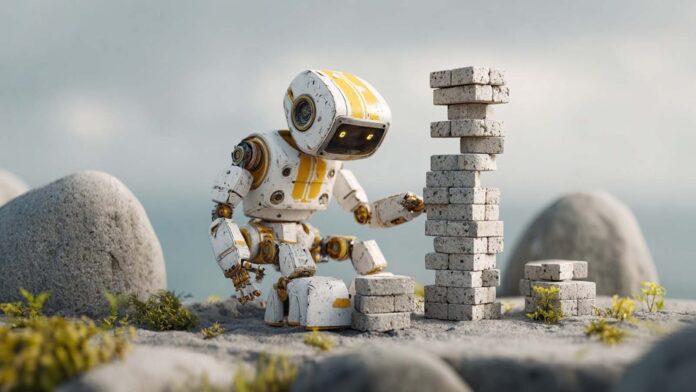Before the environmental impact of cement and steel was fully understood, the construction industry often erred on the side of caution—using far more material than necessary. This approach made sense at a time when legislation focused almost exclusively on safety.
“When in doubt, pour more concrete, add more steel, make it bigger than necessary,” says Jennifer Schooling, OBE and Director of the Cambridge Centre for Smart Infrastructure and Construction (CSIC). “But now, in the era of artificial intelligence, that approach is no longer acceptable.”
Environmental regulations now demand that materials with high carbon footprints be used more efficiently. The construction industry has passed that challenge on to technology providers. “We need a kind of new cyber-physical system,” says Schooling—one that connects the data-driven digital twin with physical reality. “It’s really urgent,” she adds, “because we can’t reduce carbon emissions if we don’t understand what we’re doing.”
Managing a construction project’s life cycle data is no small task. According to Schooling, one key element is the maximum threshold—a reference point from which everything else must be calculated: working times, material and equipment costs, types of components, safety systems… in short, everything tied to economic and environmental efficiency. On this basis, artificial intelligence is expected to help transform the traditional working model.
Adding to the complexity, the experience gained in recent years through Industry 4.0—especially in the use of digital twins to move from automation to autonomy and towards physical AI—cannot be applied directly to buildings and infrastructure.
Construction sites are far more variable than factories. The environment constantly changes. Concrete arrives wet and must dry. Weather forecasts may be better than before, but conditions can still delay or derail a schedule.
“When I talk to a group of engineers and tell them that data is never neutral, they look at me strangely,” says Schooling. “You might think that a bridge is neutral, but if you collect a set of data and fail to monitor the data that could cause it to collapse, it will collapse—no matter how much data you have.”
Growing interest in AI in construction
According to Autodesk Construction’s 2025 State of Design and Manufacturing Report, interest in AI has dipped slightly since the previous year, when the technology was being adopted at pace. Still, implementing AI and other emerging technologies remains the second most frequently cited challenge among industry executives. In part, the current shortage of skilled professionals—affecting nearly two-thirds of organisations—is acting as a catalyst.
Similarly, Grassi’s 2024 Conditions and Outlook Report for Construction, Architecture and Engineering notes that 62% of general contractors and 46% of subcontractors are actively considering introducing AI into their operations in the near future. This includes not only construction itself but also predictive maintenance. Here too, AI ranks as the second most important technology for investment, although full adoption could take 18 to 24 months, according to some executives.
Equally important as tracking AI’s progress in the sector is observing how it’s being implemented—a process that differs significantly from other industries. Few fields are as deeply intertwined in their creative and executional phases as construction.
Unlike the tightly controlled systems of Industry 4.0, construction work involves uncertainty and the need for adaptation—factors that open the door to new kinds of collaboration between human and artificial systems.
Collaboration in three phases
This is the view of architect Javier Peña Galiano, founder of Xpiral and professor of Design with Nature at the Institute for Advanced Architecture of Catalonia (IAAC). In his architectural design for the CaixaForum headquarters in Valencia, he included a 1,000-square-metre ceramic vault in the administration area. The pieces were produced by Cerámicas Cumella in Granollers (Barcelona) in twelve colours and three sizes, adding considerable variability.
Peña Galiano sees three distinct phases for applying AI in construction. In the project and design phase, it aids in conception and creation, integrating functional, figurative, metabolic and atmospheric elements into the design.
In the manufacturing phase, AI supports the production of architectural components, whether made manually, digitally or through a hybrid approach. One of its major contributions is the ability to scale processes that are currently seen as artisanal.
In the installation and execution phase, AI can support the implementation and positioning of elements on site.
In the case of the ceramic vault at CaixaForum, “a layout system was generated based on a mathematical algorithm, inspired by the movements of the person who was going to place the pieces and check that they were in the right place,” explains Peña Galiano.
This Boolean operation aimed to produce a complex surface from basic ceramic pieces. A genetic algorithm, supported by Anemone software, enabled iterative design and optimisation.
“AI has both a software and a hardware component,” says Peña Galiano. In his view, it should not be used to replace existing processes, but to achieve “something that can only be done with it. If you go to CaixaForum, you think, ‘How did they do that?’ It can only be done with these collaborative processes. It looks handmade, but it’s not possible—either because of the scale or the geometry.”
This is what sets AI in construction apart from its role in Industry 4.0.
Source:


